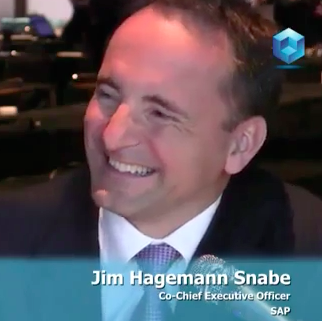 NEWS
NEWS
 NEWS
NEWS
 NEWS
NEWS
In his keynote at SAPPHIRE this morning, SAP Co-CEO Jim Hagemann Snabe made three predictions. Two of them – that within five years we will live in a completely mobile, cloud-based world – were of the relatively safe variety. The third was a bit bolder.
Snabe live on theCUBE at SAPPHIRE 2011
Within five years, he said, all the world’s data will live in main memory. I heard more than a few gasps – and I think one giggle – from the audience.
That’s an extraordinary claim to make. Yes, the price of memory is dropping and, consequently, in-memory storage is becoming an increasingly attractive option for “hot” data, a trend that will only pick up steam over the next five years. But there’s little doubt that in 2017 there will still be plenty of data living on spinning discs.
But it wasn’t such a crazy statement for Snabe to make, whether he actually believes it himself or not, when you consider the company he leads. It is clear from both Snabe’s and fellow Co-CEO Bill McDermott’s keynotes and from speaking to SAP executives and customers here at SAPPHIRE, that the German software maker finally gets Big Data, as SAP defines the term anyway.
For SAP, Big Data is about delivering insights to the enterprise that allow it to optimize business process and react in real-time to customer demands on any device from any location. To get there, Snabe said, SAP is focused on innovating in five areas: mobile, analytics, applications, database, cloud. The unifying theme that runs across all five is, yes, Big Data.
The volume and variety of data is exploding due to mobile devices and social media content. Analytics are needed to make sense of all that data in order to take action via end-user applications. That means new forms of database technology is needed to meet higher performance demands, while the cloud is in many case an ideal place to store and process all that data.
For SAP, the foundation for it all is HANA, the vendor’s purely in-memory database. And this is where SAP is blazing its own Big Data trail. While most Big Data approaches involve relatively new open source technology – Hadoop and NoSQL – or columnar analytic databases that rely heavily on disc-based storage – Vertica, Greenplum, Aster Data – SAP, as Hagemann emphasized, has lined up clearly behind main memory with HANA.
The advantage SAP has is that, as we’ve seen here at SAPPHIRE, HANA provides these benefits today. At SAPPHIRE we’ve heard from a number of SAP customers – Burberry, Ace Hardware, Coinstar/Redbox – about how they are making serious improvements to customer service and driving new revenue based on insights and real-time capabilities provided by SAP and HANA.
Said Coinstar/Redbox CEO Scott Di Valerio (hat tip ZDNet):
“Redbox sees SAP as a tool to line up new businesses over next four to five years. By putting in CRM software, and using HANA to query data from the 38 million customer e-mail addresses it has, Coinstar and Redbox can better understand renting preference patterns, which improves suggested movies and informs how it stocks its kiosks.”
The Coinstar/Redbox use case example may not be as sexy as some of the potential uses for Hadoop and other Big Data approaches, but that’s kind of the point. For SAP, Big Data must be practical and accessible today to its nearly 200,000 customers … and it is. Most of those customers probably haven’t even heard of Hadoop and don’t have the expertise or know-how to deploy and manage Hadoop even if they do know what it is.
There are disadvantage SAP must overcome when it comes to Big Data however. Namely, despite the talking points, HANA has not proven itself in truly heterogeneous environments, with most current users being long-time SAP ERP customers. Neither does HANA scale to petabyte or exabyte levels like Hadoop does, meaning currently HANA does not completely remove the need for sampling data. Finally, there’s the image problem. SAP must continue banging the Big Data/HANA drum to remove its image as a stodgy ERP vendor.
The good news for SAP is that all of these disadvantages – two of them technical, one public relations – can be overcome. SAP just might have what it takes to be a player in the Big Data market, whether or not disc goes the way of the dinosaur in five years.
THANK YOU